How the Wehrmacht was preparing for the decisive battle for Berlin
After the defeats in Poland, Silesia, Eastern Pomerania and the Red Army leaving for Oder and Neisse, the German command hastily began comprehensive preparations for the battle in the Berlin (central) direction. First of all, the German High Command was concerned about the creation of mobile reserves. To this end, in late March and the first half of April 1945, it withdrew almost everything from the first echelon of defense. tank and motorized divisions. First of all, they were hastily replenished with personnel and the material and technical part.
The creation of reserves also came at the expense of restoring previously defeated parts and connections. Separate parts that were most severely damaged in previous battles were disbanded, their personnel went on to replenish other, less affected parts. Under the leadership of the Nazi organizations continued to form battalions of Volkssturm. Only in Berlin around 200 of such battalions were formed. At the same time, the German command attempted to launch a program for training groups of so-called "werewolves" ("werewolves") for partisan-sabotage activities in the rear of the Red Army. However, in general, this program failed. The Germans could not, following the example of the Soviet Union, organize large-scale partisan activities in our rear.
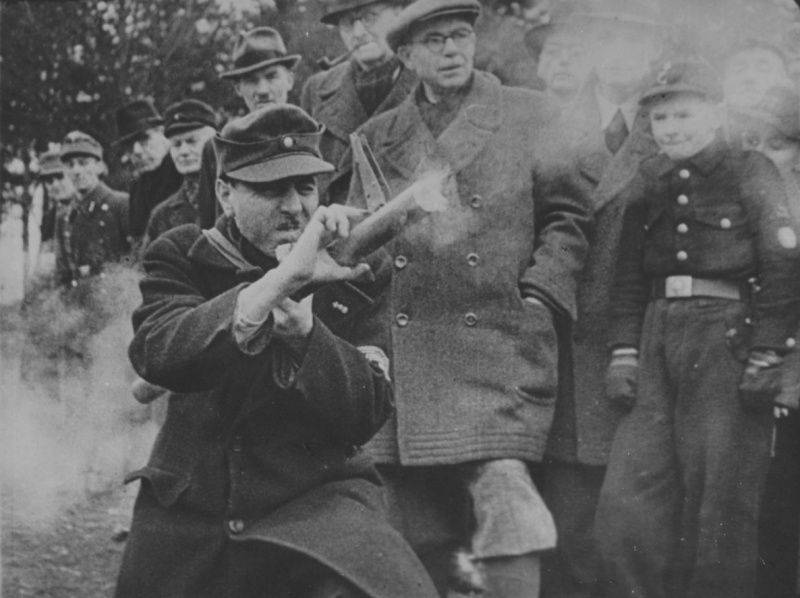
Volkssturm militia shoots from Panzerfaust grenade launcher (Panzerfaust 60) while training in Berlin
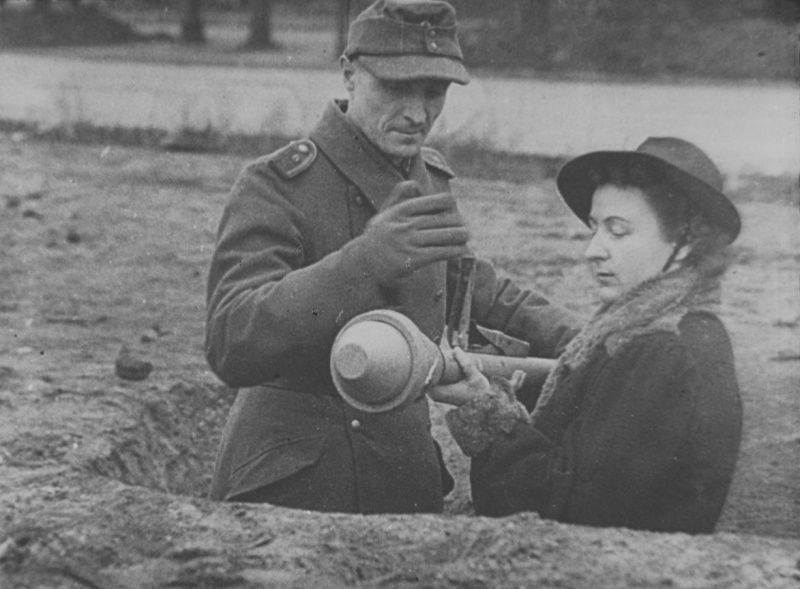
Training a female Volkssturm militiaman in using the Panzerfaust grenade launcher in Berlin
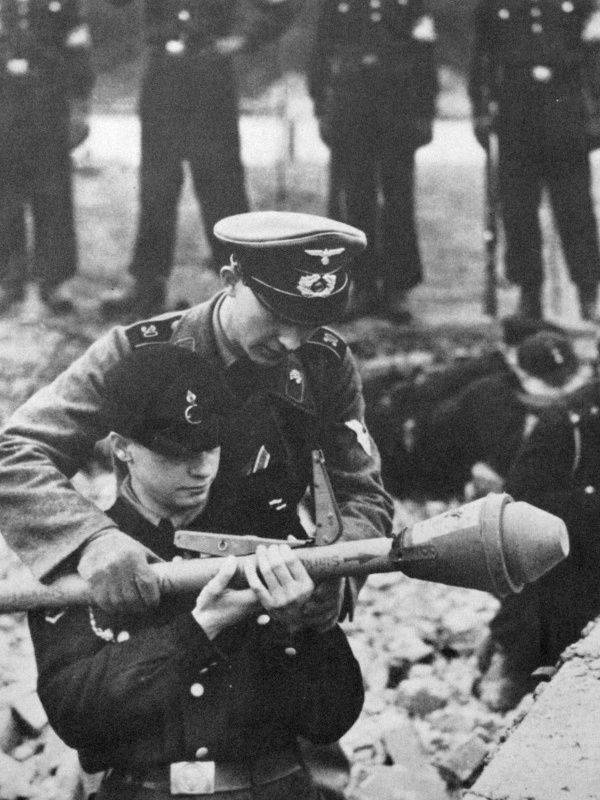
Preparing the defense of Berlin. A German soldier teaches a Hitler youth teenager how to fire a Panzerfaust grenade launcher
To strengthen the army groups "Vistula" and "Center", which defended the approaches to central Germany, the German command sent the bulk of human resources and material resources. Colonel General Yodel said after the surrender in order to replenish the divisions on the Eastern Front by the time of the decisive offensive of the Russian army, they had to disband the entire reserve army, that is, all the reserve infantry, tank, artillery and special units, schools and higher military educational institutions . Having disbanded the reserve army, the German command was largely able to restore the size and technical equipment of the units and formations of both army groups. The strength of the rifle companies was brought to 100 people by mid-April, and the infantry divisions to 7-8 thousand people.
The German command, preparing for the decisive battle, tried to raise the morale of the army. The soldiers were told that the war was being decided not in the west, but in the east, and precisely in the sector of the 9 Army. A large Russian offensive is necessary to repel and for this there are all prerequisites - people and equipment. No need to pay attention to what is happening in the west, all attention is only to the east. The retention of the Eastern Front should have been a prerequisite for a radical change in the war.
Nazi ideologues inspired the soldiers that after the victory near Berlin, the Bolsheviks would be driven back. 14 April Goebbels visited the 9 Army and called on German soldiers to be steadfast and not to allow the advance of the Russians to be a single step. April 15 Hitler in a special appeal addressed to the soldiers of the Eastern Front. He said that the high command had foreseen the blow of the Soviet troops, had created a strong front, and the Russian offensive would "choke on its own blood." Hitler expressed confidence that “Berlin will remain German. Vienna will be German again. ” At the same time, the Führer, in the same appeal, demanded that everyone be shot on the spot, regardless of rank and position, who would give the order to withdraw or retreat. "Whoever does not fulfill his duty at this moment," the German Führer declared, "will be a traitor to his people."
In the 3 military district, which was stationed in the metropolitan area, a special military court was established. He launched a wide range of activities, punishing "alarmists, cowards and traitors" and, according to the Germans themselves, "distinguished himself by a number of hasty death sentences, passed without any verification and clarification of circumstances. The High Command also issued an order on repression against the families of those soldiers and officers who surrender to the Soviet troops.
A new rotation was made in the command of the troops. Heinrich Himmler was unable to repel the offensive of the Red Army in Eastern Pomerania, the Wehrmacht’s counterstrikes did not reach the goal of disrupting the Soviet offensive against Berlin, so Colonel General Gotthard Heinritzi was put at the head of Army Group Vistula. He was considered in the German army a great master in organizing and conducting defensive battles. At the end of March 1945, Hans Krebs was appointed instead of Guderian to the post of Chief of the Ground Forces General Staff. In 1930, Krebs was for some time an assistant to the German military attache in the Soviet Union and lived in Moscow. Krebs knew Russian well, personally knew many of the highest Soviet military leaders, including George Zhukov, and was considered a specialist in the Red Army. These generals were considered staunch national socialists, personally loyal to Hitler. The Fuhrer wanted to prevent any threat of an internal coup.
At the same time, the German command, trying to delay the offensive of the Red Army, tried to misinform the Soviet command. The Germans tried to show that they have significant mobile units, ready for powerful counterattacks. The commander of military communications was instructed to increase rail traffic to the east from March 4. Trains accompanied special groups. In areas of demonstrative concentration of tank formations, a large number of tank layouts were supplied. The Germans planned to convince the Soviet command that the Berlin corps, consisting of three tank divisions and the Brandenburg tank corps, as part of two tank divisions, was concentrated against our troops in the area of bridgeheads on the Oder river. To reinforce the misinformation they used radio equipment that imitated the presence of tank headquarters headquarters. However, this attempt to misinformation failed. Our intelligence revealed the game of the enemy. Already in the first half of March, Soviet intelligence officers found that trains with models of tanks followed east.
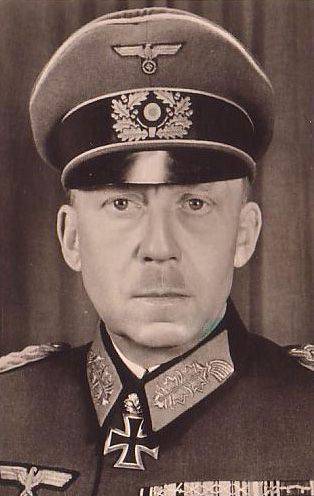
Gothard Heinrici
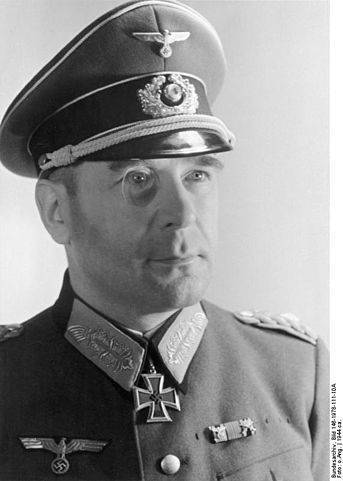
Hans Krebs
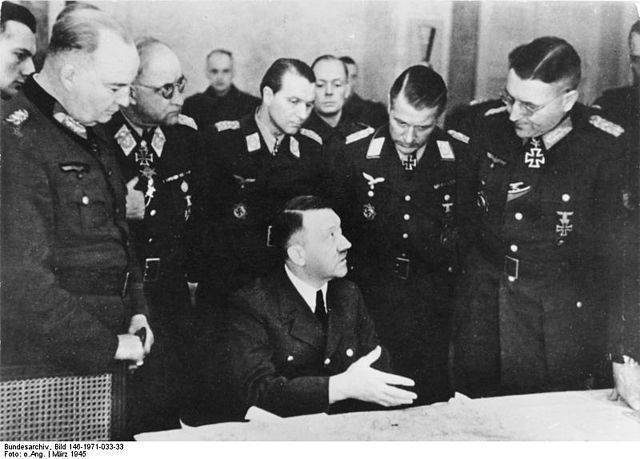
9 Army Commander Theodore Busse - far right
German troops
In preparation for the defense of Berlin, the German command in the first half of April made a regrouping of its troops. In order to securely cover the capital from the north-east direction, the main forces of the 3 tank army were transferred to its right wing, closer to the capital. Two motorized divisions were located in the Mittenwalde, Bisenbrov and Passov area. They were an army reserve.
In order to cover the German capital from the south-east direction, the command of the Army Group "Center" regrouped its reserves to the left wing in the band of the 4 tank army. Four reserve tank divisions, significantly replenished by personnel and equipment, were located in the Cottbus and Lauban area. In the defense zone of the 4 Tank Army, they also decided to redeploy the Luftwaffe elite unit 17 th Hermann Goering Parachute Tank Division and 1 Tank Division from the 20 th Field Army. Previously, these mobile units acted against the left wing of the 1 of the Ukrainian Front.
As a result of the regroupments in mid-April 1945, the German forces were positioned as follows. Army Group "Vistula" defended the right bank of the Oder in the area from Berg-Divenov (Dzivnuv), Frankfurt an der Oder, Rattsdorf. Before the 2 Belorussian Front, the Swinemünde corps and the main forces of the 120 Panzer Army were located on the 3-kilometer front sector from Berg-Divenov to Schwedt.
The Swinemünde corpus group, commanded by General Freilich, defended the isthmus north of the Stettin harbor at the front in 30 km from Berg-Divenova to Volin. The corps group consisted of the Air Force School, two battalions of marines, a marine infantry regiment, and five serf regiments (the fort regiments defended Swinemunde and Stettin). In reserve in the area of Swinemünde were part of the 402-th Training Infantry Division.
The 3-I tank army under the command of Colonel-General Hasso von Manteufel defended the 90-kilometer stretch from Neuvarp to Schwedt. The army consisted of 32 Army Corps and the Oder Army Corps. In the first echelon there were three infantry divisions, two serf regiments, two separate regiments and a battalion, a combat group. In the second echelon of the army, there were three infantry and two motorized divisions (including the SS Walloon 28 Infantry Division, the Langemak SS SS Xnumx Infantry Division, the Netherlands SS Motorized Division, the 27 Motorized Armored Division, "), Two infantry and two artillery brigades, three separate regiments, four battalions, two combat groups and an officer school. In addition, the 23 Tank Army was reinforced with three artillery regiments, an anti-aircraft division, and a Volksartillery corps. In the future, two motorized divisions - 11-i and 3-i, will be transferred to the strip of the 23-th Belarusian Front.
Thus, in the offensive zone of the 2 of the Belarusian Front, 9 of the German divisions and a significant number of separate units defended themselves (translated into divisions, the Germans had about 13,5 calculated divisions here). This group recited about 100 thousand people, 1800 guns and mortars, about 130 tanks. The main forces of the German group covered the offensive line of the main shock group of the Soviet front.
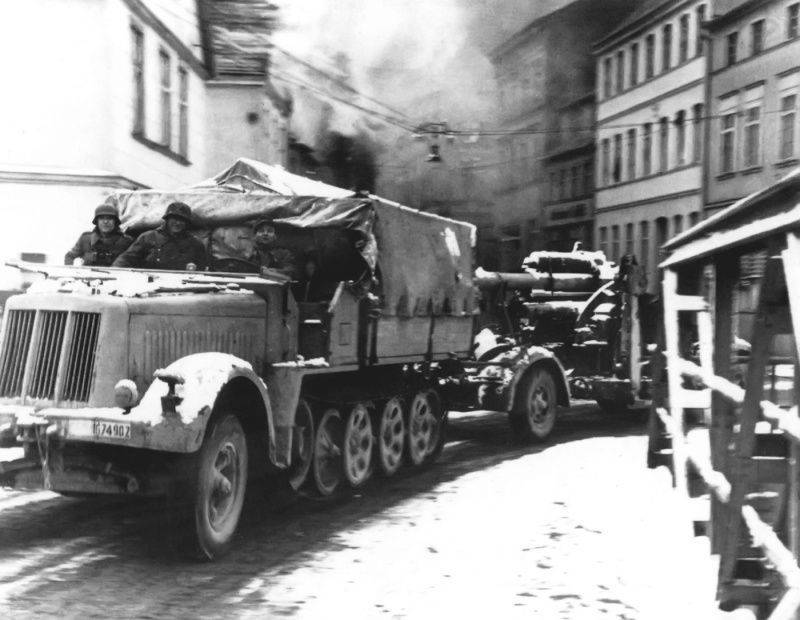
Sd.Kfz.7 heavy semi-tracked tractor tows FlaK 88-mm anti-aircraft gun on Stettin city streets
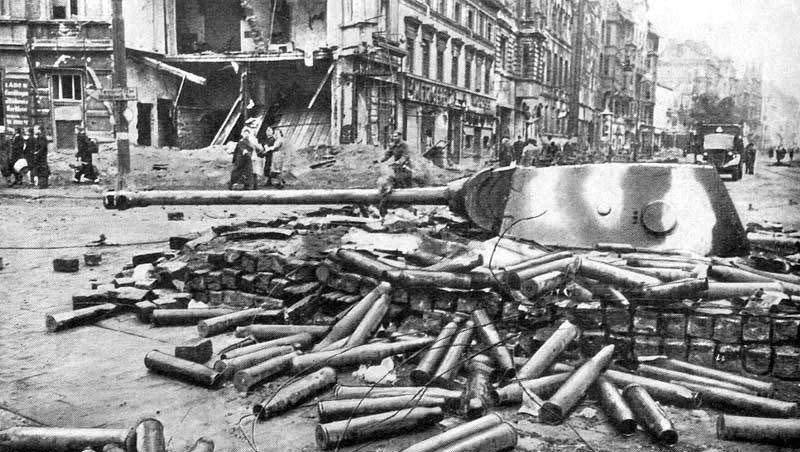
In the offensive zone of the 1 of the Byelorussian Front in the Schwedt sector, the mouth of the r. Alt Oder (25 km) in the first echelon were part of the 46-second tank corps as part of two infantry divisions. Operational reserves in the form of 23 and 11 motorized divisions were transferred to the rear of the corps. The 9-I German army under the command of Theodore Busse defended the 120-kilometer section from Alt Oder to Rattsdorf. The army consisted of the 101 Army Corps, the SS 11 Army Corps, the 39 Armored Corps, and the Mountain 5 Corps SS. In the first echelon of the army there were ten infantry and one motorized divisions, the fortress department of Frankfurt (five fortress regiments), three separate regiments and eight separate battalions. In the operational reserve were 18-I and 25-I motorized divisions, tank division "Müncheberg", motorized division "Kurmark" and 156-I infantry division. Reserves were grouped on the left flank of the army across from the Küstrin bridgehead. In addition, the 9 Army was reinforced by four Volksartillery corps, two anti-aircraft divisions, three brigades of assault guns, a mortar brigade, an artillery regiment, five anti-tank divisions, three tank and mortar battalions.
In the area of Rattsdorf, Gross-Gastrose along the Neisse River opposite the left flank of the 1 of the Belorussian Front, the 5 Army Corps of the 4 Panzer Army held defenses. It consisted of three infantry divisions.
Thus, the main line of the Oder defense line in front of the 1 of the Byelorussian Front was occupied by the 16 of the German divisions and part of the serf control of Frankfurt. There were eight divisions in the operational reserve. Together with individual units, the Germans had an offensive of the 1 of the Byelorussian Front near the 26 divisions. In addition, considerable forces were in the garrison of Berlin. Taking into account the garrison of Berlin in the offensive zone of the 1 of the Byelorussian Front, a group of about 510 thousand soldiers and officers defended, having more than 5 thousand guns and mortars and about 860 tanks and ACS. The Germans had the most dense defensive orders in front of the Küstrin bridgehead, where on average one division had 3 kilometers of front and 66 guns and 17 tanks had 1 kilometers.
Before the troops of the 1 of the Ukrainian Front, the 4 tank tank (without the 5 corps operating in the offensive zone of the 1 BF) and 17 army of the Army Group Center under the command of Ferdinand Schörner, who had special trust from Hitler, occupied the defense. The 4-I tank army of the general of the tank forces Fritz Grezer defended on the 160-kilometer sector of the front from Gross-Gastrose to Levenberg. Grezer’s army included the Great Germany Tank Corps, the 56 and 57 Tank Corps. The army consisted of six infantry divisions, a special-purpose division, the 21 tank division, the Fuhrer Guard division, the Brandenburg motorized division, the Frunberg SS tank division and the Great Germany brigade. The tank army covered the most important areas: Cottbus - Berlin, Cottbus - Torgau, Görlitz - Dresden.
The 17 field infantry general, Wilhelm Hasse, defended the 230-kilometer front from Levenberg to Krnov. The 17 army included the 8 and 17 army corps, the 48 and 40 armored corps. In total, the 17 Army had 11 infantry divisions, the 20-I tank division and the 1-I parachute tank division "Hermann Goring". 4-Panzer and 17-armies were reinforced by two anti-aircraft artillery divisions, four brigades of assault guns, three artillery, three tanks, fighter and sapper teams, two separate tank, six artillery regiments, seventeen separate artillery and seven individual anti-tank battalions.
Thus, the Germans had divisions on this front of the 24, not counting individual units and formations. In the main defense zone there were 16 infantry and motorized divisions, plus up to 18 individual brigades and regiments, 85 separate battalions and combat groups. The operational reserve was 7 divisions and a brigade. The forces of the 1 Tank Army: 4 infantry, 3 tank, 3 motorized divisions, one infantry and one engineer brigades, as well as a number of separate groups, regiments and battalions defended directly in the attack zone of the shock group of the 1 of the Ukrainian Front. The enemy's right-flank group numbered about 360 thousand people, about 3600 guns and mortars, about 540 tanks.
In the rear of the army groups "Vistula" and "Center" hastily formed reserves - 8 divisions. An army group of Steiner (two infantry divisions) was stationed in the region north of the German capital. Theodor Kerner infantry division was located in the Lager Deberitsa area, the Yang infantry division and the 2-I parachute motorized Hermann Goering division near Uterbog, the Moser corps (three infantry divisions) in the Dresden region. Militia battalions were formed in all cities and large settlements.
Particular attention of the German leadership was focused on the Kustrin-Berlin and Kotbussky directions. Here were concentrated the most dense groups of troops and concentrated the main reserves. At the same time, the German command was preparing to launch counterattacks on the flanks of the Soviet strike forces in order to foil the Soviet offensive. Northeast of Berlin was concentrated 5 motorized, one armored and 2 infantry divisions. They were supposed to strike at the flank of the shock group of the 1 of the Belarusian Front to thwart the attack on Berlin. In the same counterattack, reserve formation divisions that were hastily formed should take part.
The command of the army group "Center" grouped three divisions and one division in the Cottbus area against the right flank of the 1 of the Ukrainian Front in the Cottbus region. These troops were to launch a counterattack against the Soviet troops from the southeast. In addition, 1's Hermann Goering Parachute Tank Division and 20 Tank Division were deployed to the Görlitz area.
In general, the Germans concentrated a large group in the Berlin direction against the troops of the 2nd and 1st Belorussian and 1st Ukrainian fronts. The armies of the three Soviet fronts operated: 48 infantry divisions, 6 tank, 9 motorized, 37 separate infantry regiments, about 100 separate infantry battalions, a large number of separate artillery, engineering and other units and formations. The German group consisted of about 1 million people, 10400 mortar guns, more than 1500 tanks. German command created a fairly strong aviation the group, transferring to the Berlin area the most combat-ready units and formations of the Air Force, which included more than 3300 combat aircraft.
To be continued ...
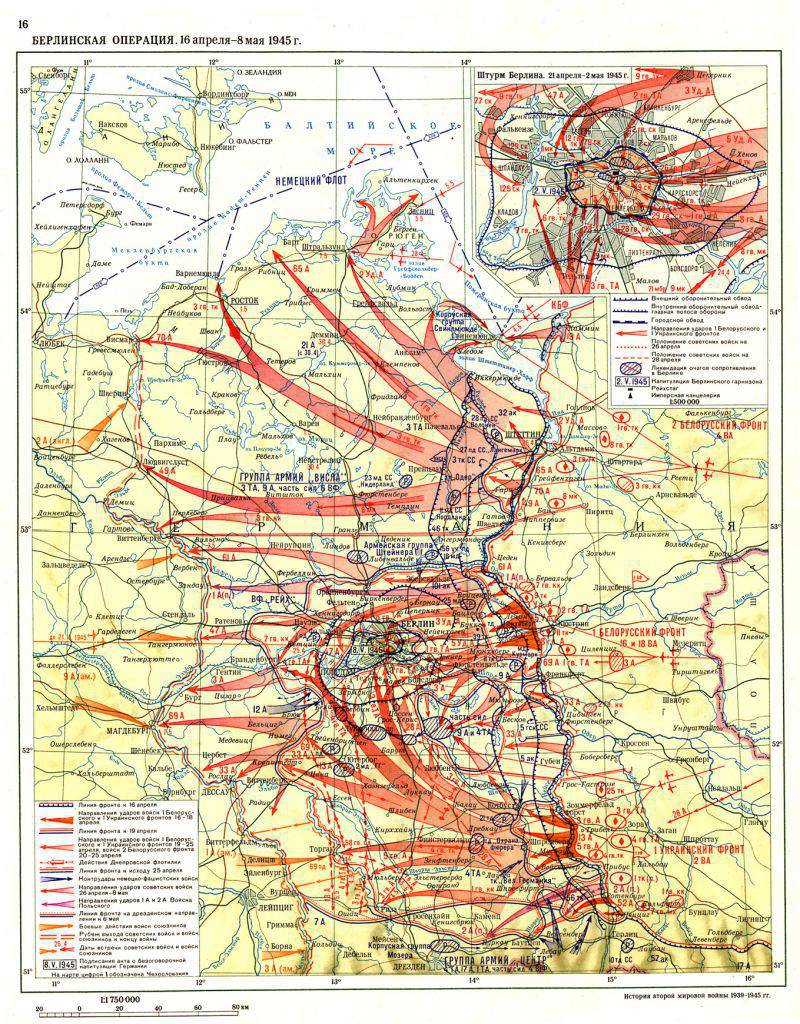
Information